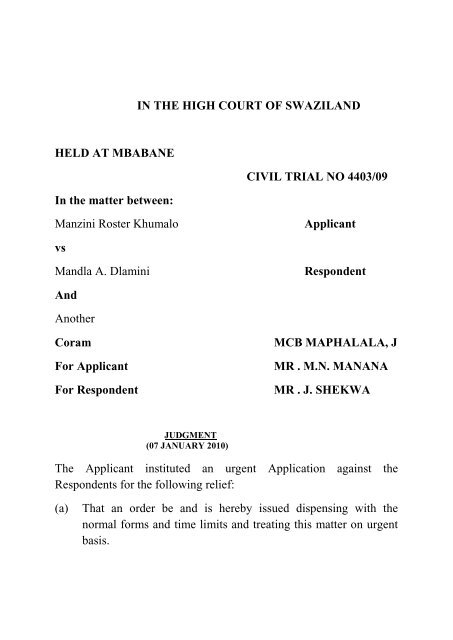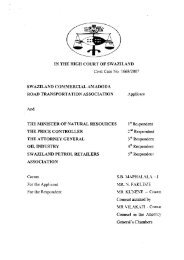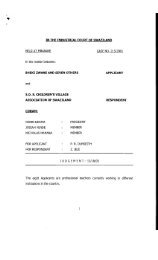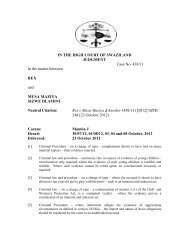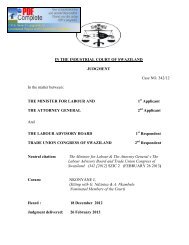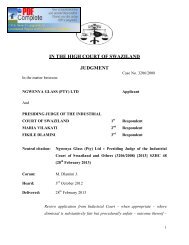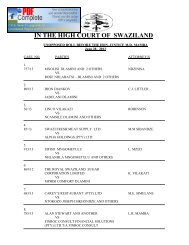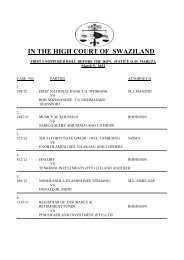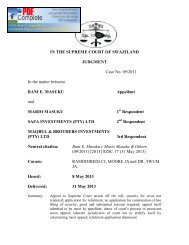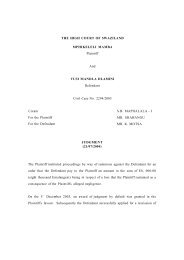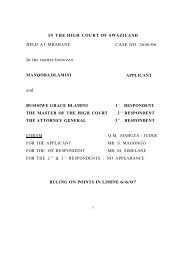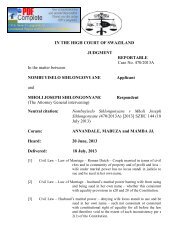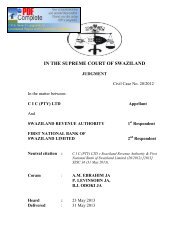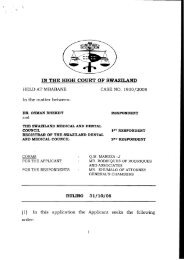Khumalo v Dalmini.pdf - SwaziLII
Khumalo v Dalmini.pdf - SwaziLII
Khumalo v Dalmini.pdf - SwaziLII
- No tags were found...
You also want an ePaper? Increase the reach of your titles
YUMPU automatically turns print PDFs into web optimized ePapers that Google loves.
(b)(c)(d)(e)(f)That an order be and is hereby issued interdicting andrestraining the First Respondent from burying the deceasedminor child Naledi Lerato Dlamini at his parental home.That an order be and is hereby issued giving the rights to burythe said deceased minor child to the Applicant.That an order be and is hereby issued restraining the SecondRespondent from releasing the body of Naledi Lerato Dlamini tothe First Respondent.Costs of Application.Further and/or alternative relief.[1] A Rule Nisi was issued by this Court on the 31st December2009 in terms of Prayers (a), (b) and (d) returnable on the 7thJanuary 2010.[2] It is common cause that the Applicant and First Respondentwere married to each other in terms of Civil Rites on the 11thAugust 1989; and, a final decree of divorce as between theparties was issued on the 6th August 2001 by the ManziniMagistrate Court.[3] Custody of the minor children Naledi Lerato Dlamini, thedeceased, and Tebogo Manelisi Dlamini was given to theapplicant in terms of a Divorce Settlement agreed to by theparties and made an Order of Court.[4] The Applicant alleges that at the time that the marriage wassolemnized, the Applicant was already pregnant with thedeceased child. Neither dowry nor the penalty for impregnatingthe Applicant was paid to her family by the First Respondent interms of Swazi Law and Custom. However, since the marriagebetween the parties is by Civil Rites, I will decide thisApplication on the basis of the Common Law.
[5] Applicant alleges that since their birth, she has been responsiblefor the maintenance of the minor children without the assistanceof the First Respondent. The latter has denied this in hisAnswering Affidavit. However, the Applicant has annexed tothis Application an affidavit deposed to by the First Respondenton the 5th October 2007; Paragraphs 2 and 3 of the Affidavitread as follows:“I was previously married and later divorced from Ms ManziniRoster <strong>Khumalo</strong>. Two children were born of the said marriagenamely Naledi Lerato Dlamini and Tebogo ManelisiDlamini….My former wife has throughout the lives of our children,financially maintained them. This included catering for all theirschool expenses as I was unable to do so. She has continued todo so even after leaving Swaziland to live and work in theUnited Kingdom.”[6] Ironically, the First Respondent in his Answering Affidavitadmits that he deposed to this affidavit but states that it was afabrication by himself intended to obtain visas for the minorchildren so that they could join the Applicant in England topursue their education there. I don’t believe this particularlybecause the Affidavit was signed and sworn to before a NotaryPublic.[7] It is common cause that after the decree of divorce had beengranted the Applicant bought a home at Ngwenya Village. Shethen migrated to England for employment and left the minorchildren in the care of a minder Sisi Ndlovu; the latter hasdeposed to a Confirmatory Affidavit which is annexed to thisApplication. The minder and children were residing atApplicant’s home at Ngwenya Village.
[8] The deceased child died on the 20th December 2009 in a trafficaccident; and, the Applicant was at her place of employment inEngland. The minder Sisi Ndlovu and Applicant’s sister askedthe First Respondent to assist them in identifying the body in hiscapacity as the father to the deceased.[9] The First Respondent caused the body of the deceased to betaken to the Second Respondent’s mortuary pending burial; hecompleted all necessary documentation and signed themsignifying that he was the person who had brought the deceased.By implication, he is the only person who could signdocumentation releasing the body of the deceased from theSecond Respondent.[10] The two families have reached a deadlock as to the place ofburial of the deceased; each of them wants to bury her. TheApplicant argues that she has the right to bury her partlybecause she has the custody over the deceased and partlybecause she was solely responsible for the support andmaintenance of the deceased during her lifetime. She furtherargues that the First Respondent cannot be heard to seek burialrights over the deceased when he failed to be a parent to herduring her lifetime and that he never bothered to support andmaintain her.[11] The issue before Court relates to the burial rights of the parties.The First Respondent on the other hand argues that he has theright of burial in his capacity as the biological father; and thatafter his divorce with the Applicant, he retained guardianshipover the deceased and that the deceased followed his domicile.He further denies that he failed to support the children; however,he did not submit any proof in the form of receipts for theschool fees he allegedly paid at Mjingo High School, BahaiHigh School, Cefups College and Mathew Phosa College where
the children were schooling. He has not even annexed aConfirmatory or Supporting Affidavit to prove that hemaintained and supported the children.[12] The Applicant in her Replying Affidavit sought to dismiss theAnswering Affidavit on the basis that it did not have a stampcontrary to the Stamp Duty Act. On perusal of the originalAnswering Affidavit, I discovered that it was duly stamped;hence, that Point of Law cannot stand.[13] H.R. Hahlo in The South African Law of Husband and Wife,4th edition at page 458 states:“Guardianship in its widest sense includes custody, andembraces the care and control of the minor’s person as well asthe administration of his property and business affairs. Wherecustody and guardianship are separated, the custodian parenthas the care and control of the minor’s person, while theguardian parent administers his property and businessaffairs.”[14] At pages 463 – 464, the learned author has this to say:“Where, as it happens in most cases, custody is awarded to themother and no order is made as to guardianship, the father isleft with guardianship minus custody. The mother, as thecustodian parent, is entitled to have the child with her; tocontrol its daily life; to decide all questions relating to itseducation, training and religious upbringing; to determinewhat homes or houses the child may or may not enter and withwhom it may or may not associate….By virtue of hisguardianship, it is the father’s right and duty to take charge ofand administer the property of the minor; invest his moneys;pay his debts; and contract on his behalf in business matters.In legal proceedings the minor must be represented or assisted
y the father, unless the mother obtains leave from the Courtto bring or defend an action on the minor’s behalf.”[15] P.O.R. Boberg in the Law of Person and the Family, Secondedition, at page 459-462 defines custody as follows:“Custody is that portion of the parental power which pertainsto the personal life of the child. Spouses who live togethershare custody…. But where the consortium isterminated,whether through separation or divorce, custodyis… awarded to one parent leaving the other with residuaryguardianship….An award of custody to a mother entrusts to her all that is meantby the nurture and upbringing of the minor children. In this isincluded all that makes up the ordinary daily life of the child –shelter, nourishment, and the training of the mind.… Thechild… passes into the home of the mother, and there it mustfind all that is necessary to its growth in mind and body…. Acustodian parent has… the right to regulate the life of the child,determining with whom he should or should not associate, howhe should be educated, what religious training he should receive,and how his health should be cared.The non-custodian parent has no right to interfere in thesematters, though he may petition the court to do so if it appearsthat the custodian has exercised his discretion in a mannercontrary to the interests of the child or in conflict with an Orderof Court. Otherwise he is confined to his right of access to thechild.”[16] The learned author continues and deal with “residuaryguardianship” at page 463 as follows:“An order awarding the custody of a child to the mother doesnot and cannot encroach upon the father’s paternal power
save in so far as the exercise of that power would beinconsistent with the mother’s custody. He remains the child’snatural guardian and retains his power to administer thechild’s property, represent or assist him in legal proceedings,and authorize him to enter into legal transactions. Hisconsent (together with that of the mother) is still required forthe child’s marriage. On the other hand, the power to changethe child’s residence, influence his citizenship or determine hisdomicile… passes to the custodian parent.”[17] It is common cause that custody of the deceased minor childwas granted to the Applicant. In terms of the Common Law, sheis the one who controls the daily life of the child including herplace of residence and her health. The First Respondent wasonly left with the “residuary guardianship” which only entitleshim to assist the child in legal transactions where she lackedlegal capacity. From this, it follows that the Applicant has theright to bury the deceased child.[18] I am further satisfied that the Applicant has been solelyresponsible for the financial support and maintenance of thedeceased as evidenced by the Affidavit deposed to by the FirstRespondent and annexed to the Founding Affidavit. Similarly,it is apparent from the pleadings that from 2001 when the decreeof divorce was issued, the deceased had been under the care ofthe Applicant until she met her death on the 20th December2009; she resided at the home of the Applicant and the latter wasresponsible for her daily life.[19] In the circumstances the Rule Nisi is hereby confirmed in termsof Prayers (a), (b) and (d). I further grant Prayers (c) and (e).The costs awarded to the Applicant shall be on the ordinaryscale.
M.C.B. MAPHALALAJUDGE OF THE HIGH COURT OF SWAZILAND


